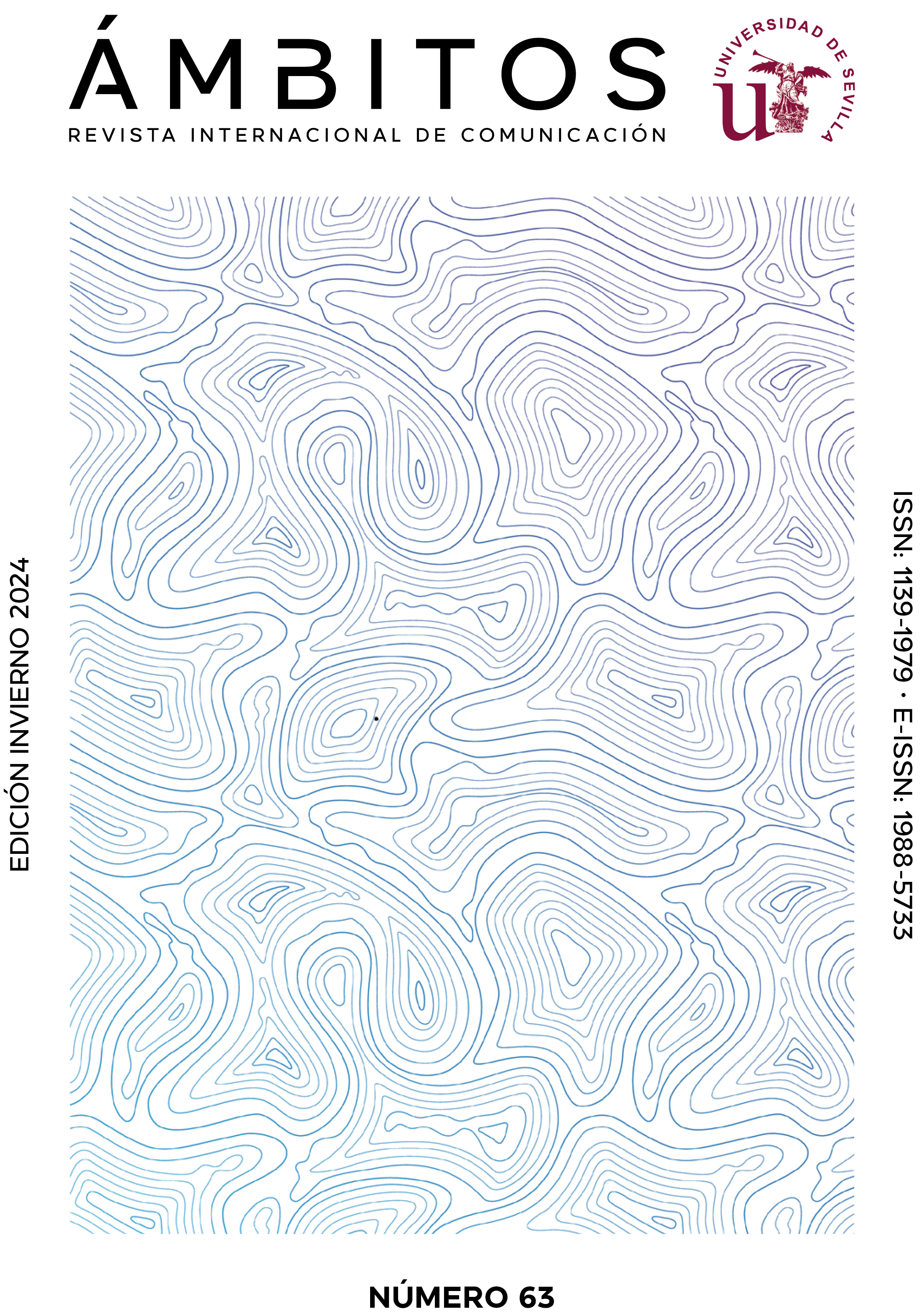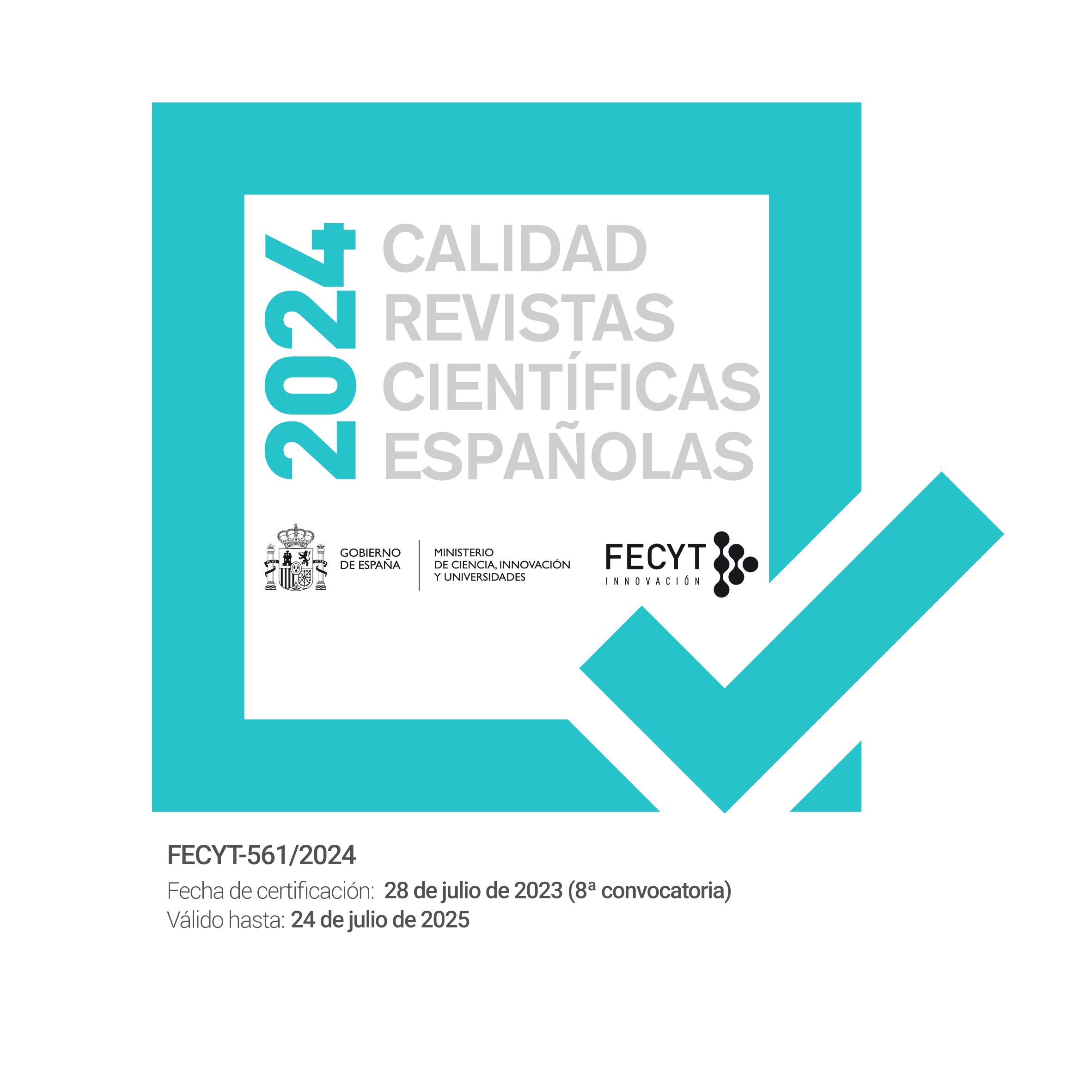La sostenibilidad del vídeo participativo como práctica comunitaria. El caso de InsightShare
DOI:
https://doi.org/10.12795/Ambitos.2024.i63.01Palabras clave:
Medios comunitarios, video participativo, sostenibilidad, InsightShareResumen
La discusión académica en torno a la sostenibilidad en los medios de comunicación ha evolucionado mucho recientemente, sobre todo en torno a los medios alternativos, comunitarios y del Tercer Sector. Frente al enfoque economicista de los análisis de la sostenibilidad de los medios comerciales y de la evaluación de los medios públicos en relación con la influencia del poder político, los medios comunitarios han movilizado una concepción de la sostenibilidad que considera aspectos como la estructura organizativa, la diversidad de los equipos de trabajo o el equilibrio medioambiental. El presente artículo se acerca al vídeo participativo como práctica comunitaria para explorar los patrones de sostenibilidad que éste pone en juego. Se parte de una amplia revisión bibliográfica en torno a la sostenibilidad en los medios comunitarios, así como de un análisis crítico de la literatura disponible en torno al vídeo participativo. A nivel empírico, se examina el caso de estudio de InsightShare, una organización de origen británico que constituye una referencia en la práctica del vídeo participativo. El texto concluye que la sostenibilidad de InsightShare se articula en torno a la priorización de las relaciones comunitarias, tanto en lo que respecta al funcionamiento de la propia organización como en relación con los proyectos en los que la misma participa. La capacidad de InsightShare para desarrollar su misión en circunstancias distintas y el papel jugado en la articulación de experiencias autónomas representan un ejemplo de buenas prácticas en lo que respecta a la concepción de la sostenibilidad en sentido amplio.
Descargas
Citas
Adams, W. C. (2015). Conducting semi-structured interviews. En K. E. Newcomer, H. P. Hatry &, J. S. Wholey (Eds.), Handbook of practical program evaluation (pp. 492-505). Wiley.
Aimaretti, M. (2018). Democratización social y video participativo: El (olvidado) aporte de Qhana a la historia del audiovisual boliviano de los ochenta. Revista Ciencia y Cultura, 22(41), 81–104. https://acortar.link/7GUA1e
Atton, C. (2001). Alternative media. Sage.
Barranquero, A. (Coord.) (2015). Juventud española y los medios del Tercer Sector de la Comunicación. Centro Reina Sofía sobre Adolescencia y Juventud y FAD.
Barranquero, A., & Candón-Mena, J. (2020). La sostenibilidad del Tercer Sector de la Comunicación en España. Diseño y aplicación de un modelo de análisis al estudio de caso de El Salto y OMC Radio. REVESCO. Revista de Estudios Cooperativos. https://doi.org/10.5209/reve.71863
Barranquero, A., & Montero, D. (2015). La elaboración de una cartografía sobre los medios del tercer sector en España. Descripción de un proceso de investigación colaborativa. Revista internacional de pensamiento político, 10, 17–25. https://acortar.link/JuDHUr
Binder, I., Fisher, P., & Godínez Galay, F. (2017). Como sea. Sostenibilidad económica-administrativa en radios comunitarias de Argentina. Jinete Insomne. https://bit.ly/3MWL8ku
Bowen, G. A. (2009). Document analysis as a qualitative research method. Qualitative Research Journal, 9(2), 27–40. https://doi.org/10.3316/QRJ0902027
Braden, S., & Nelson, V. (1999). Communities meet policy-makers through video-supported analysis: Rural energy issues in Malawi. PLA Notes, (34), 57–62.
Brennen, B. S. (2021). Qualitative research methods for media studies. Routledge. https://doi.org/10.4324/9781003122388
Buckley, S. (2011). Community media: A good practice handbook. UNESCO Publishing.
Cadavid, A. (2008). Las cinco estaciones [elementos para entender la sostenibilidad]. En R. Escobar, V. Salgado, & E. Dávila (Eds.), Atrapa sueños. La sostenibilidad en las radios populares y comunitarias (pp. 13–23). ALER y AMARC-ALC.
Carelli, V. (2013). Video nas aldeias, una propuesta de seducción cultural. Revista Chilena de Antropología Visual, (21), 51–63.
Downing, J. (2001). Radical Media: Rebellious Communication and Social Movements. Sage Publications. https://doi.org/10.4135/9781452204994
Diverse. (2013). Community radio annual report 2012. Ofcom
Dziopa, F., & Ahern, K. (2011). A systematic literature review of the applications of Q-technique and its methodology. Methodology: European Journal of Research Methods for the Behavioral and Social Sciences, 7(2), 39–55. https://doi.org/10.1027/1614-2241/a000021
Escobar, R., Salgado, V., & Dávila, E. (2008). Atrapa sueños. La sostenibilidad en las radios populares y comunitarias. ALER y AMARC-ALC. https://bit.ly/47N7q00
Fairbairn, J. (Ed.). (2009). Community Media Sustainability Guide. USAID, Internews & Pact. https://bit.ly/47ivXdn
Fisher, P. (2019). By any means: Paths to sustainability for Argentina’s community radio stations. Journal of Alternative & Community Media, 4(4), 80–92. https://doi.org/10.1386/joacm_00068_1
Fraser, C., & Restrepo, S. (2001). Community Radio Handbook. UNESCO. https://bit.ly/3sFyZcK
Galindo Flores, A. (2022). Shift the power: Exploring the business model of a non-profit social enterprise that is Doing Development Differently. UCL.
García García, J. (2015). Obstáculos y posibilidades al despliegue de las emisoras comunitarias. En A. Nerekan, M. A. Casado, R. Zallo, & J. C. Miguel de Bustos (Eds.), Comunicación de proximidad: cada vez más lejos. Marco, experiencias y regulación (pp. 279–296). Universidad del País Vasco. https://bit.ly/49NQHLK
Gordon, J. (2015). The Economic Tensions Faced by Community Radio Broadcasters. En C. Atton (Ed.), The Routledge companion to alternative and community media (pp. 278–288). Routledge.
Gumucio Dagron, A. (2001). Making Waves: Stories of Participatory Communication for Social Change. Rockefeller Foundation.
Gumucio Dagron, A. (2005). Arte de equilibristas: La sostenibilidad de los medios de comunicación comunitarios. Punto Cero, 10(10), 6–19.
Gumucio Dagron, A., & Hezekiel, D. (2005). Sustainability of CMCs. Guidebook on setting up a community media center. Unesco. https://bit.ly/3RdRIFx
Haye, R. M. (2016). Medios sustentables más allá de lo económico. En R. M. Haye & O. E. Bosetti (Eds.), Encrucijadas del nuevo milenio: radio, comunicación y nuevas tecnologías (pp. 156–174). Under Ediciones.
High, C., Singh, N., Petheram, L., & Nemes, G. (2012). Defining participatory video from practice. En C. Mitchell, N. de Lange, & E.-J. Milne (Eds.), Handbook of Participatory Video (pp. 35–49). Altamira Press.
InsightShare. (2021). Annual Report. https://bit.ly/49N4Etk
Johansson, R. (2007). On case study methodology. Open House International, 32(3), 48–54. https://doi.org/10.1108/OHI-03-2007-B0006
Kaplún, G. (coord.) (2019a). ¿Vivir o sobrevivir? Sostenibilidad de las alternativas mediáticas en Uruguay. Altermedia y Friedrich Ebert Stiftung. https://bit.ly/40TOx9k
Kaplún, G. (2019b). La comunicación alternativa entre lo digital y lo decolonial. Chasqui. Revista Latinoamericana de Comunicación, (141), 67–86. https://doi.org/10.16921/chasqui.v0i141.4077
King, G., & Rahemtullah, O. S. (2019). Community radio contradictions in Canada: Learning from volunteers impacted by commercializing policies and practices. Journal of Alternative & Community Media, 4(4), 20–36. https://doi.org/10.1386/joacm_00064_1
Lunch, N., & Lunch, C. (2006). Insights into participatory video: a handbook for the field. Insightshare.
Milne, E. J. (2016). Critiquing participatory video: Experiences from around the world. Area, 48(4), 401–404. https://doi.org/10.1111/area.12271
Mitchell, C., De Lange, N., & Moletsane, R. (2016). Me and my cellphone: Constructing change from the inside through cellphilms and participatory video in a rural community. Area, 48(4), 435–441. https://doi.org/10.1111/area.12142
Montero, D., & Moreno, J. M. (2014). El cambio social a través de las imágenes. Los Libros de la Catarata.
Montero Sánchez, D., & Moreno Domínguez, J. M. (2020). Explorando el campo de conocimiento del video participativo. Un recorrido por las principales aportaciones teórico-prácticas. Revista Internacional de Comunicación y Desarrollo (RICD), 3(11), 92–108. https://doi.org/10.15304/ricd.3.11.6345
Montero Sánchez, D. (2021). Rethinking participatory video in the times of YouTube. Media Culture & Society, 43(1), 101–116. https://doi.org/10.1177/0163443720948017
Morales, T., Muñiz, S., Montero, D., & Moreno-Domínguez, J. M. (2021). Autonomía y sostenibilidad en prácticas de vídeo participativo con comunidades indígenas. El caso de La Marabunta Filmadora. Andamios. Revista de investigación social, 18(47), 397–422. https://doi.org/10.29092/uacm.v18i47.882
Morgan, H. (2022). Conducting a qualitative document analysis. The Qualitative Report, 27(1), 64–77. https://doi.org/10.46743/2160-3715/2022.5044
Mowbray, M. (2015). Alternative Logics? Parsing the literature on alternative media. En C. Atton (Ed.), The Routledge companion to alternative and community media (pp. 21–31), Routledge.
Mtimde, L., Bonin, M.-H., Maphiri, N., & Nyamaku, K. (1998). What is community radio? A resource guide. AMARC Africa and Panos Southern Africa. https://bit.ly/48pYZb3
Mutibwa, D. (2015). Between aspiration and reality. En C. Atton (Ed.), The Routledge companion to alternative and community media (pp. 278–288). Routledge.
Nightingale, A. (2009). A guide to systematic literature reviews. Surgery (Oxford), 27(9), 381–384. https://doi.org/10.1016/j.mpsur.2009.07.005
Pavarala, V., Malik, K. K., Belavadi, V., Deshbandhu, A., & Raghunath, P. (2014). Community Radio Continuous Improvement Toolkit (Version 2.0). UNESCO Chair on Community Media, University of Hyderabad. https://bit.ly/3QVDxDA
PV-NET. (2008). The Walton Hall Statement on Participatory Video in Research. Paper presented at the PV-NET Closing Conference, Walton Hall.
Randolph, J. (2009). A guide to writing the dissertation literature review. Practical Assessment, Research & Evaluation, 14, e13.
Rodríguez, C. (2001). Fissures in the Mediascape. An International Study of Citizen’s Media. Hampton Press.
Servaes, J. (1999). Communication for Development: One World, Multiple Cultures. Hampton Press.
Shaw, J., & Robertson, C. (1997). Participatory Video. A Practical Approach to Using Video Creatively in Group Development Work. Routledge.
Shaw, J. (2012). Beyond Empowerment Inspiration: Interrogating the Gap between the Ideals and Practice Reality of Participatory Video. En E. J. Milne, C. Mitchell, & N. de Lange (Eds.), Handbook of participatory video (pp. 225–242). Altamira Press.
Stuart, S., & Bery, A. (1996). The Power of Video in the Hands of Grassroots Women Video SEWA: A Case Study. En J. Servaes, T. Jacobson, & S. White (Eds.), Participatory Communication for Social Change. Sage.
Van Vuuren, K. (2009). The value and purpose of community broadcasting: The Australian experience. En J. Gordon (Ed.), Notions of Community: A Collection of Community Media Debates and Dilemmas (pp. 173–195). Peter Lang.
Walsh, S. (2016). Critiquing the politics of participatory video and the dangerous romance of liberalism. Area, 48(4), 405–411. https://doi.org/10.1111/area.12104
Publicado
Cómo citar
Número
Sección
Licencia
Derechos de autor 2024 José Manuel Moreno Domínguez, Dr. David Montero Sánchez

Esta obra está bajo una licencia internacional Creative Commons Atribución-NoComercial-CompartirIgual 4.0.
Ámbitos. Revista Internacional de Comunicación es una revista de acceso abierto, lo que significa que todo su contenido está disponible gratuitamente para el usuario o su institución. Los usuarios pueden leer, descargar, copiar, distribuir, imprimir, buscar o enlazar con el texto completo de los artículos, o utilizarlos para cualquier otro fin lícito, sin solicitar permiso previo al editor o al autor. Esta definición de acceso abierto se ajusta a la Iniciativa de Acceso Abierto de Budapest (BOAI).

A menos que se indique lo contrario, todo el contenido de la edición electrónica se distribuye bajo una " licencia internacional Creative Commons Attribution-NonCommercial-ShareAlike 4.0 ". Puede consultar la versión informativa y el texto legal de la licencia aquí. Esto debe indicarse expresamente de esta manera cuando sea necesario.
En caso de aceptación del manuscrito, los autores ceden los derechos de la obra para su publicación a Ámbitos. Revista Internacional de Comunicación bajo el contrato de licencia Reconocimiento-NoComercial-CompartirIgual 4.0 Internacional (CC BY-NC-SA 4.0). Los autores conservan los derechos de autor y terceros están autorizados a copiar, distribuir y hacer uso de la obra, siempre que cumplan con los términos y condiciones establecidos en la licencia.
- Citar la autoría y la fuente original de publicación (revista, editorial y URL de la obra).
- No los utilice con fines comerciales.
- Si remezcla, transforma o crea a partir del material, debe publicar sus contribuciones bajo la misma licencia que el original.
Se puede encontrar más información en https://creativecommons.org/licenses/by-nc-sa/4.0/deed.es



















